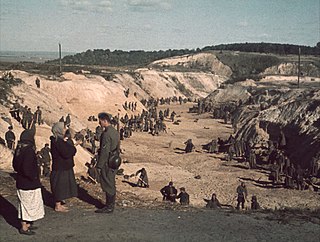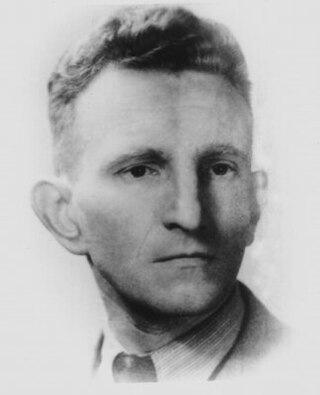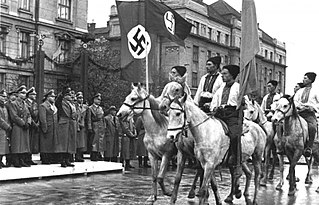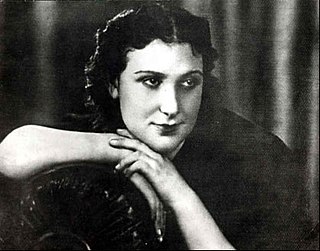
Ivan Andriyovych Rohach (Ukrainian : Іван Андрійович Рогач) (29 May 1913 – 21 February 1942) was a Ukrainian journalist, poet, writer, and political activist.

Ivan Andriyovych Rohach (Ukrainian : Іван Андрійович Рогач) (29 May 1913 – 21 February 1942) was a Ukrainian journalist, poet, writer, and political activist.
Rohach was born in Velykyi Bereznyi (Hungarian : Nagyberezna), Ung county, Austria-Hungary (modern-day Ukraine). From 1933 to 1938, he was the editor of the Novoyi Svobody newspaper in Uzhhorod, in Carpathian Ruthenia, then part of Czechoslovakia and today in western Ukraine. Between 1938 and 1939, he was the personal secretary to Avhustyn Voloshyn, the nominal Prime-Minister of Carpatho-Ukraine during its several days of independence in March 1939 before it was occupied by Hungary following the First Vienna Award. Rohach was an active supporter and member of the Ukrainian scouting movement, Plast. [1]

Rohach was a prolific writer of political pamphlets and short stories dealing with various aspects of religion, human morality, the national question, and the cause for Ukrainian self-determination. He was a member of the Organization of Ukrainian Nationalists (OUN) and a supporter of the Andriy Melnyk faction (OUN-M). He moved to Kyiv during the German occupation in order to aid in the re-establishment of a Ukrainian administration in the nation's capital.
In January 1942, Rohach became the co-editor of the newspaper Nove Ukrainske Slovo ("New Ukrainian Word") [2] and the magazine Lytavry ("Tympani"), which united those active in Ukrainian culture and arts in Kyiv. The newspaper expressed strong antisemitic sentiments. In 1941, the paper described Jews as the "greatest enemy of the people." [3]
In 1941, Rohach was arrested by the Gestapo during a crackdown on Ukrainian nationalist activities, after he and others refused unconditional cooperation with the Germans. [4] Rohach was taken to Babi Yar where he, along with his sister, Anna (Hanna), and his entire staff, was executed. [2]

Poems from his collection of poetry Brosti have been set to music. A number of the songs have been included in the Plast song book U mandry ("To wander") and continue to be sung by Ukrainian scouts today. [5]
In 1992, a wooden cross memorial was erected in memory of Olena Teliha and executed OUN members. It is located in Babi Yar south of Yuriia Illienka Street (formerly until 2018 Melnyk/Melnykov Street) at Oleny Telihy Street in northwestern part of Kyiv near Dorohozhychi subway station. [6] : memorial #15 Rohach's name is the 6th from the top on the right side marble plaque. [7] : 41

Babi Yar or Babyn Yar is a ravine in the Ukrainian capital Kyiv and a site of massacres carried out by Nazi Germany's forces during its campaign against the Soviet Union in World War II. The first and best documented of the massacres took place on 29–30 September 1941, in which some 33,771 Jews were murdered. Other victims of massacres at the site included Soviet prisoners of war, communists and Romani people. It is estimated that a total of between 100,000 and 150,000 people were murdered at Babi Yar during the German occupation.

Stepan Andriyovych Bandera was a Ukrainian far-right leader of the radical militant wing of the Organization of Ukrainian Nationalists, the OUN-B.
The Organisation of Ukrainian Nationalists was a Ukrainian nationalist organization established in 1929 in Vienna, uniting the Ukrainian Military Organization with smaller, mainly youth, radical nationalist right-wing groups. The OUN was the largest and one of the most important far-right Ukrainian organizations operating in the interwar period on the territory of the Second Polish Republic. The OUN was mostly active preceding, during, and immediately after the Second World War. Its ideology has been described as having been influenced by the writings of Dmytro Dontsov, from 1929 by Italian fascism, and from 1930 by German Nazism. The OUN pursued a strategy of violence, terrorism, and assassinations with the goal of creating an ethnically homogenous and totalitarian Ukrainian state.

Olena Ivanivna Teliha was a Ukrainian poet and activist of the Organization of Ukrainian Nationalists (OUN) of Ukrainian and Belarusian ethnicity.

Anatoly Vasilievich Kuznetsov was a Russian-language Soviet writer who described his experiences in German-occupied Kiev during World War II in his internationally acclaimed novel Babi Yar: A Document in the Form of a Novel. The book was originally published in a censored form in 1966 in the Russian language.

Roman-Taras Yosypovych Shukhevych was a Ukrainian nationalist and a military leader of the nationalist Ukrainian Insurgent Army (UPA), which during the Second World War fought against the Soviet Union and to a lesser extent against the Nazi Germany for Ukrainian independence. He collaborated with the Nazis from February 1941 to December 1942 as commanding officer of the Nachtigall Battalion in early 1941, and as a Hauptmann of the German Schutzmannschaft 201 auxiliary police battalion in late 1941 and 1942.

Ukrainian collaboration with Nazi Germany took place during the occupation of Poland and the Ukrainian SSR, USSR, by Nazi Germany during the Second World War.

The Kurenivka mudslide occurred on 13 March 1961 in Kyiv, then a city in the Ukrainian SSR, Soviet Union. It took place near the historic Babi Yar ravine, which had been the site of the mass murder of more than 100,000 Jews and other civilians during World War II. The mudslide began at the edge of the ravine and dumped mud, water, and human remains into the streets of Kyiv. The Soviet authorities suppressed information about the disaster, and claimed 145 people were killed, while forbidding any memorial events for the victims. A 2012 study in Ukraine estimated that the number of victims was closer to 1,500.

Volodymyr Panteleimonovych Bahaziy was a Ukrainian nationalist affiliated with Andriy Melnyk who was head of Kyiv City Administration under German occupation from October 1941 to February 1942.
Kabayda Anatoly (Кабайда Анатолій a.k.a. Anatolij Zukiwskyj a.k.a. - Medvid was a Ukrainian community and political activist.

The Holocaust in Ukraine was the systematic mass murder of Jews in the Reichskommissariat Ukraine, the General Government, the Crimean General Government and some areas which were located to the East of Reichskommissariat Ukraine, in the Transnistria Governorate and Bessarabia, Northern Bukovina and the Hertsa region and Carpathian Ruthenia during World War II. The listed areas are currently parts of Ukraine.
Babi Yar, a ravine near Kyiv, was the scene of possibly the largest shooting massacre during the Holocaust. After the war, commemoration efforts encountered serious difficulty because of the policy of the Soviet Union. After the dissolution of the Soviet Union, a number of memorials were erected. The creation of the Babyn Yar Holocaust Memorial Center was initiated in 2016.

Ulas Oleksiiovych Samchuk was a Ukrainian writer, propagandist, publicist, journalist, and a member of the Government of the Ukrainian People's Republic in exile. He was a member of the nationalistic Organization of Ukrainian Nationalists, a Nazi collaborator, and noted antisemite.
Poems about Babi Yar commemorate the massacres committed by the Nazi Einsatzgruppe during World War II at Babi Yar, in a ravine located within the present-day Ukrainian capital of Kyiv. In just one of these atrocities – taking place over September 29–30, 1941 – 33,771 Jewish men, women and children were killed in a single Einsatzgruppe operation.

Dina (Vera) Mironovna Pronicheva was a Soviet Jewish actress at the Kiev Puppet Theatre, military communications-trained 37th Army of the Soviet Union veteran, and a survivor of the 29–30 September 1941 Babi Yar massacre of Jews by Nazi German forces in Kyiv who also worked for the German occupation.

Tetyana Yosypivna Markus was a member of the anti-Nazi underground in Kiev.

Babi Yar Holocaust Memorial Center, officially the Foundation and Babyn Yar Holocaust Memorial Center, is an educational institution that documents, explains and commemorates the Babi Yar shootings of September 1941 and aims to broaden and sustain the memory of The Holocaust in Eastern Europe, taking into account geopolitical changes during the 20th century. On September 29, 2016, President of Ukraine Petro Poroshenko, together with public figures and philanthropists, initiated the creation of the first Babi Yar Holocaust Memorial Center. The Memorial Center is planned to be opened in Kyiv, Ukraine, in 2025/26.
Symbolic synagogue and place for prayer in Babyn Yar - is an art object of the Babi Yar Holocaust Memorial Center, built on the territory of the National Historical Memorial Preserve "Babyn Yar" as a part of preparations to commemorate the 80th anniversary of the first massacres in Babyn Yar.

Babi Yar. Context, also known as Babyn Yar. Context, is a 2021 documentary film by the Ukrainian filmmaker Sergei Loznitsa that explores the prelude and aftermath of the World War II massacre of nearly 34,000 Jews at Babi Yar in Kyiv, Ukraine in September 1941.

Oleksiy Makukhin is a Ukrainian producer, media manager, and public activist who serves as the general director of the Babyn Yar Holocaust Memorial Center.